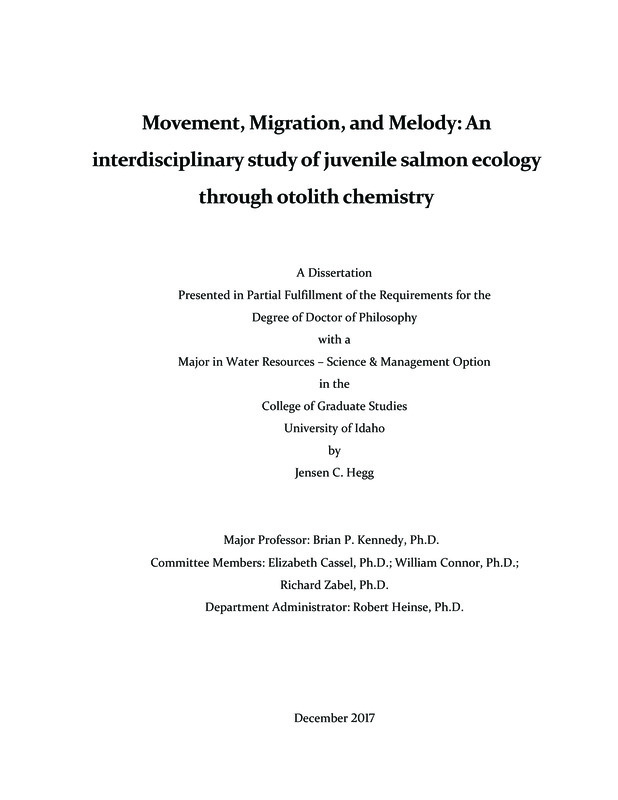Movement, Migration, and Melody: An interdisciplinary study of juvenile salmon ecology through otolith chemistry
Hegg, Jensen C.. (2017-12). Movement, Migration, and Melody: An interdisciplinary study of juvenile salmon ecology through otolith chemistry. Theses and Dissertations Collection, University of Idaho Library Digital Collections. https://www.lib.uidaho.edu/digital/etd/items/hegg_idaho_0089e_11285.html
- Title:
- Movement, Migration, and Melody: An interdisciplinary study of juvenile salmon ecology through otolith chemistry
- Author:
- Hegg, Jensen C.
- ORCID:
- 0000-0003-0125-9287
- Date:
- 2017-12
- Keywords:
- dynamic time warping isotope geochemistry life history migration migration ecology otolith
- Program:
- Water Resources
- Subject Category:
- Ecology; Biogeochemistry; Biology
- Abstract:
-
The movement of animals has important ecological consequences from the scale of the individual to the ecosystem. As populations move they exert important impacts on the ecology of the ecosystems they inhabit. Ultimately, the migratory movement of populations and the resulting large-scale effects are based on the movement of individuals, which are often influenced by conditions experienced at the individual scale. Understanding the relationship of individual movements to the temporal and spatial variation of conditions across the landscape, provides important insights on the ecology of populations. This dissertation focuses on the ecology of movement in juvenile fish populations using otolith microchemistry, the recovery of trace chemistry from the balance organs of fish, as an ecological tool to link detailed fish movement with population processes. The first chapter introduces the combined use of 87Sr/86Sr in otoliths, and the prediction of 87Sr/86Sr variation using geologic maps, to reconstruct the movements of goliath catfish in the Amazon basin, a species which undertake the longest freshwater migration on earth and whose migrations are poorly understood due to their scale and remote location. The remaining chapters focus on Snake River fall Chinook salmon, examining changes in the timing of juvenile outmigration which may be evolving due to environmental and anthropogenic influences. Chapter 2 examines the complexities in interpreting the transition from maternally derived to environmentally derived otolith chemistry in young juvenile salmon. Chapter 3 introduces a novel time-series statistical method to analyze fish movement, and compares it to a more standard multi-tracer approach. Chapter 4 combines the analysis methods from the prior chapters to build a mixed-effect model relating size at ocean entry to the effects of location, environment, and growth at multiple juvenile stages using a ten-year sample of returning adult salmon otoliths. Chapter 5 details the results of a collaborative, interdisciplinary experiment to test the preliminary use of data-to-sound sonification as a method for exploring otolith datasets.
- Description:
- doctoral, Ph.D., Water Resources -- University of Idaho - College of Graduate Studies, 2017-12
- Major Professor:
- Kennedy, Brian P
- Committee:
- Zabel, Richard W; Connor, William P; Cassel, Elizabeth J
- Defense Date:
- 2017-12
- Identifier:
- Hegg_idaho_0089E_11285
- Type:
- Text
- Format Original:
- Format:
- application/pdf
- Rights:
- In Copyright - Educational Use Permitted. For more information, please contact University of Idaho Library Special Collections and Archives Department at libspec@uidaho.edu.
- Standardized Rights:
- http://rightsstatements.org/vocab/InC-EDU/1.0/

